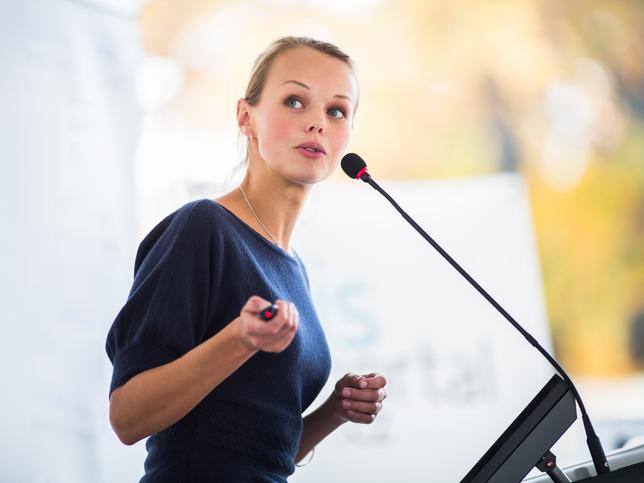Few tools are more important to our survival, in my opinion, than the desire to see through someone else’s eyes. The primary mechanism of that metaphysical sight is storytelling, which helps to generate empathy, that all-important feeling. We know in our bones – and research supports this – that the shortest distance between two people is a story. Powerful public speaking is in essence skilful storytelling before an audience.
Why public speaking matters in higher education
Public speaking is a crucial skill for higher education faculty. Effective communication is essential for conveying complex ideas, engaging students and enhancing learning. Beyond teaching, faculty often present research to an audience of peers and professionals in their field. They may also engage with administrators and external subject matter experts to collaborate on projects, secure funding through grants and advance their careers.
- Resource collection: ‘Power skills’ for 21st-century academia
- We’ve forgotten how to communicate science to the public at a crucial time
- Humans develop humans
Speaking with – and in front of – others undergirds all these activities. Harnessing storytelling in public speaking creates true connections between speaker and audience.
As the director of the Center for Communicating Science at Virginia Tech, my mission is to help scientists, scholars, medical professionals and sustainability leaders strengthen their communication skills by listening to their audiences, empathising with them, finding points of commonality, using metaphors and telling stories about their work. Storytelling becomes easier when you speak about something you’re passionate about. Then, it comes from the heart. Embellish the story if needed, but be authentic at the same time.
Techniques to improve public speaking
By extending tools I’ve learned as an actor to empower researchers in communicating, I work with faculty to hone their public-speaking skills. Targeted exercises derived from the theatre build the muscles of connection. Then we practise, practise and practise. And, to mix metaphors, I tell people to see public speaking as like running a marathon – you take a few steps first, then run around the block, and gradually build up your mileage until you can run the full distance.
I encourage people to be acutely aware of non-verbal communications. About 93 per cent of what is received is non-verbal. Think about your gestures, your facial expressions. Use them to draw people in.
Timing is also important; slow down when you speak in front of an audience. People may feel pressured to fit absolutely everything into their presentation, so they rush through their delivery. We encourage speakers to do the exact opposite. Pause at the end of an important point. A short period of silence lets the audience absorb what you’ve said, process the information and reflect on what they’ve heard and learned. Part of every experience is reflection.
Five tips for effective public speaking
There are five dimensions to effective public speaking – the kind that builds bridges with audiences through storytelling:
- Get personal. I like to borrow a saying from Theodore Roosevelt: “We don’t care how much you know until we know how much you care.” Connecting with your audience builds trust, and sharing stories and emotions allows you to do that. It goes back to putting yourself in others’ shoes and feeling empathy and curiosity towards them.
- Be direct. Get rid of the fancy words we use in our discipline that only set us apart. Drop the acronyms and the jargon. Instead, find language commonalities with your audience and then use those shared words to connect. Use metaphors to clarify complex concepts.
- Think of your presentation as a conversation. I’ve learned that scientists often struggle with this idea. They’ll say they want to work on their proverbial elevator pitch – but I wouldn’t want to be in that elevator with them. An elevator pitch goes one way. Instead, think of your delivery as a two-way conversation.
- Be responsive and spontaneous. That is, read the room. Remember that you’re communicating with other people. Observe what is happening with them; be aware not just of yourself but of your audience and tune in to the context of the human being on the other side of the communication bridge. Is it an 8am presentation? Acknowledge the earliness of the hour, maybe make a quip about it and build rapport through shared laughter.
- Be emotionally vivid. In graduate school, students are taught to learn our material, be objective and leave emotions out of it. In public speaking, we want the opposite. Share your humanity, talk about your struggles or triumphs. Making an emotional connection is more powerful than logic or data. You’ll feel it when you’re connecting with your audience.
Improving science communication requires purposeful practice of skills such as listening and being personal, direct, spontaneous and responsive. You can’t communicate effectively if you are boring people. Faculty who can eloquently and persuasively articulate their ideas – through stories – are more likely to attract attention and engage their peers, students and the broader academic community. Connecting through storytelling can also be joyful and rewarding for both speakers and audience members.
Patricia Raun is director of the Center for Communicating Science at Virginia Tech and professor of theatre in the School of Performing Arts. She was director of the School of Performing Arts from 2002 to 2016.
If you would like advice and insight from academics and university staff delivered direct to your inbox each week, sign up for the Campus newsletter.




comment